Music as an infrastructure: a choice of headphones
 How to choose earphones? First of all, you need to estimate the budget, choose what size and type of headphones you need, and then evaluate the sound quality of suitable models. A huge number of headphones are being produced now, and it’s very difficult to find the ones that suit you personally. I hope this guide on models and types of headphones helps you make the right choice.
How to choose earphones? First of all, you need to estimate the budget, choose what size and type of headphones you need, and then evaluate the sound quality of suitable models. A huge number of headphones are being produced now, and it’s very difficult to find the ones that suit you personally. I hope this guide on models and types of headphones helps you make the right choice. But no, it won’t help!Choosing headphones for myself, I once realized that despite the enormous amount of resources - articles, reviews, tests, discussions on the forums - that seem to be trying to help me, I am really terribly lonely. If an article or post is written from the most neutral position, then they are only useful for self-education, but not for choice. Everything else - forums, advice from sellers, even sincerely trying to help, friends and acquaintances - often "help" choose headphones that make your head ache and no buzz. What to do?
My approach is this: sound quality and price should be considered last, or not at all. Convenience, comfort and relevance to the task should be the main criteria. That is, a) I do not buy headphones just because the authoritative magazine called them “Product of the Century” b) I do not consider the device beyond the budget available to me. In previous posts, I tried to justify why this approach really simplifies the life of a music lover. Why not consider the purchase of headphones, players, and more, as an investment in infrastructure?
Disclaimeror How to Read This Post. First: do not believe me! Do not forget that everything said here applies to my personal choice. I just tried to explain as honestly as possible why my choice was just that. I am extremely subjective, but unlike most other "authors about the sound" I consider it necessary to immediately announce it. Second: do not believe me! And in general to anyone who tries to describe the sound of headphones or speakers in words. It’s the same as retelling the contents of films, the same meaningless task. Since I could not completely get rid of word forms such as “velvet, but collected bottoms, articulated mid frequencies”, they are highlighted in red. Third: do not believe me! Despite the fact that I tried to abstract as much as possible from prices, sound quality, design and the like, they still influenced my choice. Just because that I did not have the opportunity to evaluate, try on and compare dozens of different models. Most of you will not have this opportunity either, and this is the only benefit of such posts: choosing another person helps you make your own choice. Yes, not one of the mentioned manufacturers paid me for posting this post. I paid them :)
Setting the task
I have three main scenarios for listening to music: at home, at work and on trips. The requirements for these three options are slightly different. At home, you need the most comfortable headphones for long listening. At work, I need to isolate myself from external office noise, and I also need the ability to quickly take off and put on my headphones - if I need to talk to someone or answer a phone call. On trips (public transport, metro, airplanes), maximum isolation from external noise and compact dimensions are required: the headphones should fit in your pocket and always be at hand.
Is it possible to do with one pair of headphones for all these cases? Of course you can, and in any case there will be gags - according to the most demanding scenario “in transport”. But since I am an advanced music lover, for each case I have a separate pair. I’ll try to evaluate them according to my favorite criterion: convenient / not convenient. Beyerdynamic DT880
House

( Review on Kenrockwell.com)
These are open-type headphones, that is, they almost do not isolate external noise. What you listen to, everyone else will hear just as well. That is, these headphones are not suitable for the office, unless you have a separate office: it will be noisy, the open-office neighbors will listen to your tyts-tyts and get angry. If you choose universal headphones for home and office, then these will be closed headphones. Why didn’t I do that? The fact is that open headphones differ from closed ones in sound.
No, I'm not talking about the fact that "open sound better." Open headphones are as close as possible to the sound of ordinary speakers. I am sure that Beyerdynamic has a completely identical model in a closed case, which sounds exactly the same. With one exception: if the “open” ones almost match the sound of a regular speaker system in a spacious room, then the closed ones look more like a small box with speakers screwed to the sides, and to listen you need to put your head in there. This all directly affects comfort: open headphones can be listened for longer without getting tired.
Convenient
Three-meter twisted cord that does not get confused and allows you to move around the desktop without removing the headphones. And even reaches for the sofa.
The most simple, but comfortable design. Soft fabric ear cushions with minimal pressure on the ears. Reliable metal headband: in other models it is often plastic, and breaks in the first place. Fairly light weight.
Inconvenient
This is a rather subjective moment, but in some cases, after a couple of hours of listening, the headband begins to tangibly put pressure on me. Perhaps this is due to the fact that a rather thin leather lining covers the metal strip.
Alternatives
There are a lot of “big” headphones, so choosing the right ones so that they don’t put pressure on your head (and on your wallet) is quite simple. It is important to try on headphones before buying, and if you feel at least minimal inconvenience in five minutes, don’t take it. In three hours, this minimal inconvenience will surely turn into one continuous frustration.
As you can see, my only complaint with headphones is that in some cases the headphones put pressure on my head (and just shift them a little to stop). Is there any radical solution to this problem? There is, for example, Audio-Technica:
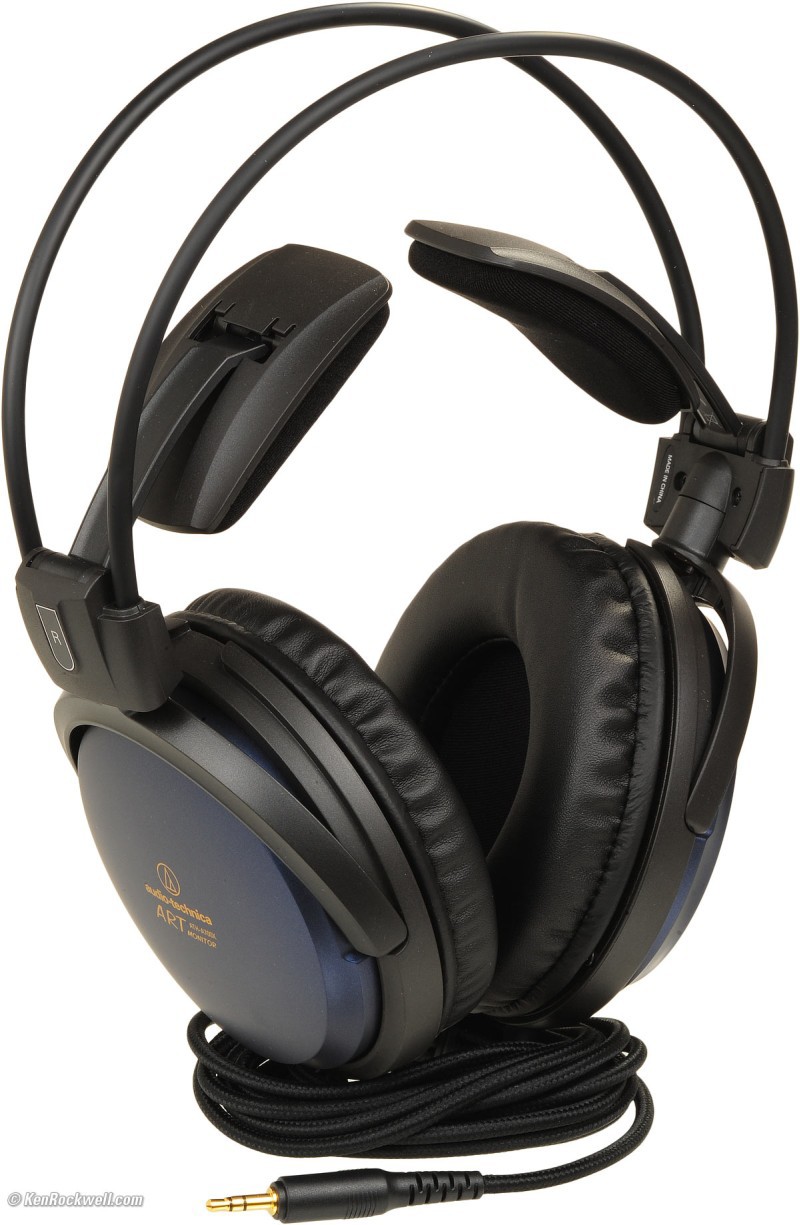
Headphone review on kenrockwell.com .
Such a design, in principle, can not push much, and when I tried on this model in the store, it seemed to me very comfortable. There is a minus: any sudden movement of the head, and the headphones are shifted, or even fall off.
The work of the
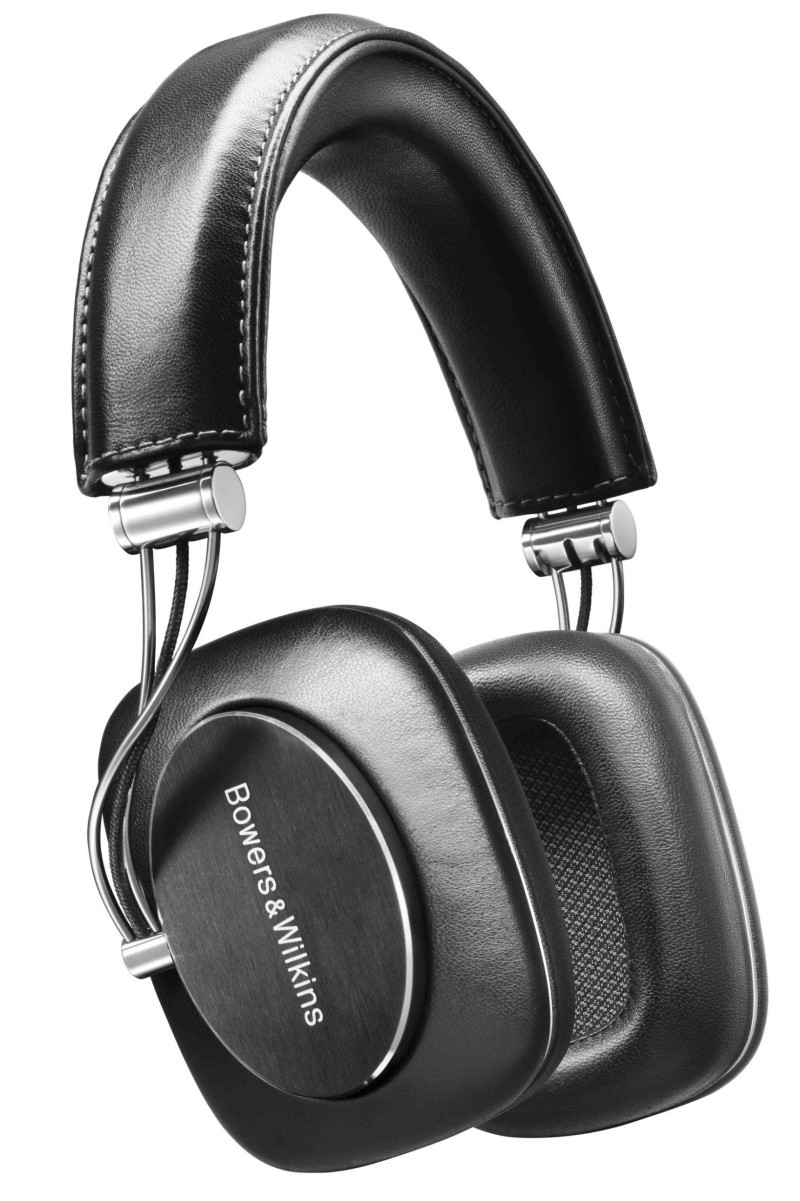
B&W P7 ( InnerFidelity review ) The
B&W P7 is such a good compromise. Large but folding. They fold, but firmly sit on the head and do not play. They sit firmly on their heads, but not much pressure, thanks to high-quality materials and thick ear pads. The result was such a multifunctional model: I listen to them at work, sometimes I use them in transport (mainly in the summer, when the cap does not interfere), and occasionally I take along with gags on trips.
Conveniently
A short cord, even with a remote control for i-devices. For some reason, many large closed headphones fall into the “professional” category, and therefore are equipped with a three-meter cord. This is good for home, but at work such a cable will be constantly confused.
Correct folding design. Before that, I had closed Beyerdynamic DT660 headphones, and the ear cups turned there. This means that such headphones constantly play on the head: not very well. P7 fold “in”, and securely locked in a “combat” position.

Uncomfortable
Taki put pressure on his head. But, firstly, it is tolerant, and secondly - here it is justified. The better the headphones are pressed to the ears, the better the noise is isolated. P7 can even be used in the subway.
About the sound. These are headphones for those who are called bassheads in English forums. I also relate to those, I love, you understand, so that it’s “rocking”. The sound of the P7 is very different from the Beyerdynamic DT880 - the former are close to what is usually called “neutral sound”. P7 is not at all neutral, but also attractive. Like any other attempt to “shift” the sound away from the theoretical ideal, this is such an individual taste: if I like these headphones, it does not mean at all that you will like it. It is necessary to listen.
Alternatives
The headphones are portable, and at the same time, _not_plugs_ are presented in a large assortment. These are on-ear models (B&W P5 for example), which do not completely cover the ear, and just lightweight headphones with large emitters (Sennheiser Momentum). I deliberately narrowed down my choice by wishing it was that big headphones, but foldable, moreover, suitable for office and travel. If you don’t bother with such complex materials, it’s quite simple to find large headphones that are suitable for almost any situation.
Travel

Earsonics SM3v2
Plugs, or in-ear-monitors, are the most common type of headphones. But it was not easy for me to find a suitable model according to the criteria of convenience and reliability. Why? Very simple. Big headphones are harder to break, even if they are made of not the best plastic. My Beyerdynamic DT880, I hope, will last more than a dozen years, especially since I can not take them out of the house. “Gags” - by definition, more compact and delicate - and live in the most severe conditions, and cause much more problems. For example:
• Sooner or later, the cable fails.
• If they sit tight in their ears, they rub their ears.
• If loose - fall out at the most inopportune moment.
• Nozzles regularly clogged with earwax (bue)
As a result, the plugs fail quickly. And if so, then you need to buy expensive gags carefully. Since I chose all the headphones on the top bar of a reasonable budget for me, I wanted them to last a long time, be comfortable and sound good.
These are pretty tough selection criteria that cut off most models. I will try to detail them:
• Replaceable cable
• Earhook. That is, the headphones should be fixed not only due to the nozzles.
• Replaceable nozzles and filters available for order (not all headphones can be ordered _parts_ in principle).
As a result, I opted for earphones EarSonics - a small French company whose main specialization is compact headphones-monitors for performers at concerts.
Conveniently
Replaceable cable. No matter how reliable the standard headphone-plug cable is, it will certainly fail sooner or later. Therefore, to be honest, I do not understand the meaning of super-expensive headphones, in which it is impossible to change the cable.
Convenient silicone nozzles. Traditional disclaimer: convenient for me. They are quite soft, but at the same time provide good insulation. But the foam tips (comply foam tips), the choice of many owners of earphones-plugs, I did not like. Nozzles in such models for 90% determine whether the headphones are suitable for you or not. You can not try on different headphones with different nozzles in all stores, and sellers who keep special demo models in stock are all the more valuable.
BTE mount. Technically, it is implemented very simply: where the cable connects to the headphones, a cambric is provided in which the wire is inserted. Thanks to this, the headphones are held not only due to the nozzle. An additional bonus: it is technically impossible to mix up the left and right headphones.
Uncomfortable.
They are large and quite heavy. There are earplugs that don’t feel at all in the ear, and it’s very cool. If the dimensions are important to you, then it’s better not to buy “big plugs”. In this case, the size is due to the presence of three reinforcing radiators inside, including a rather big bass one.
Lack of cable with remote control for smartphone. For me, a small loss, since I usually do not listen to music on a smartphone. And if I'm listening, then you can answer the call without removing the headphones, just talking on the phone. But for someone, this option may be critical. Fortunately, other manufacturers have an assortment of headphones of a similar design, but with a remote control.
In my current infrastructure, these are the oldest headphones, they are already more than 2 years old. Recently I had to carry out a full maintenance. What happened during this time? Firstly, the connector began to fall apart, which connects the cable to the headphone. This is obvious, since it has an additional load due to behind-the-ear fastening. Sooner or later, the microscopic mount would finally fall apart.
Two pairs of silicone nozzles failed. Clogged filters inserted in the sound guide. If the nozzles simply torn and began to pop off (take out the earphone - the nozzle remains in the ear, very unpleasant), then due to the filters, at one fine moment, the left channel began to play noticeably quieter. EarSonics is not such a cool manufacturer as Sennheiser, and accessories for their headphones are almost never sold, only a direct order from France. I decided to save (in vain), and began to experiment with third-party nozzles, filters and cable.
The only luck is the Etymotic filters, which turned out to be identical to the original. Then everything was bad. Etymotic earbuds did not hold well and constantly flew due to the fact that they were designed for headphones of a different design. Nozzles from another manufacturer did not fit at all. The interchangeable Fiio cable pleased me with a terrible microphone effect - this is when you hear the wire rubbing against a jacket and other objects, since it is too hard.
In general, it was decided to order a “repair kit” from the manufacturer: a proprietary cable and, with a margin, more branded nozzles.
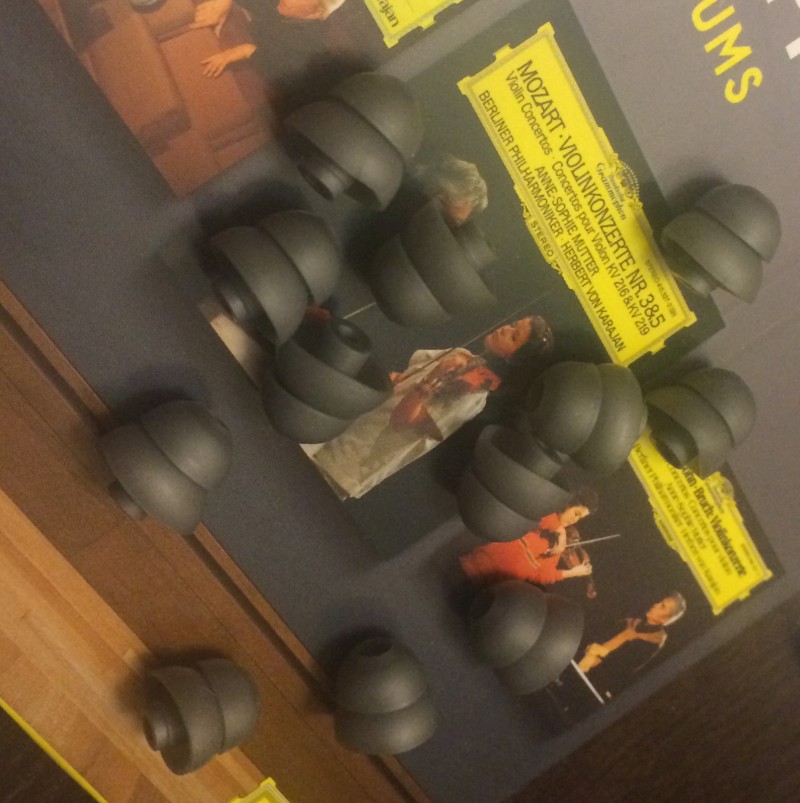
I hope that for at least a couple of years the headphones will work without problems. At the same time, a new, more compact connector compatible with covers for iPhone and other smartphones pleased the cable:
EarSonics makes reinforcing headphones, which are very noticeably different from headphones, with ordinary, dynamic emitters (let's put it bluntly: small speakers!) In terms of sound character.
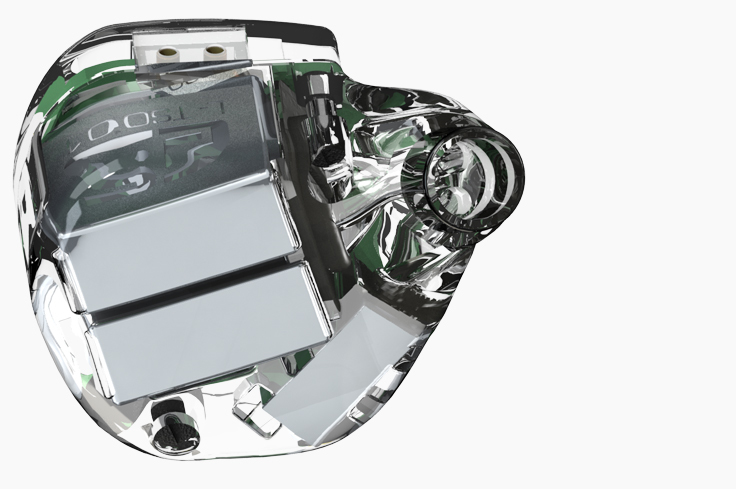
In my opinion, the sound of reinforcing headphones is good in its detail: all instruments are perfectly audible in the recording of a symphony orchestra, their nuances can be endlessly tasted and studied. This detail can play a bad service to other genres: heavy music, emotional, noisy with this same analyticity is not good friends. Well, when you want to shake with a haer , so to speak, and you are offered to study the length of the nails on the guitarist’s right hand. In part, multi-driver fittings solve this problem when several emitters are used in the headphones (in my case, three, and sometimes six, or even eight), although there is an opposite opinion on this. In any case, reinforcing headphones are not cheap, but if they fit into the budget, I recommend comparing them with dynamic ones that are similar in price.
Alternatives
Thousands of them. Let's look at the tasks:
I talked a lot about the reliability and maintainability of the headphones. It turns out that seemingly simple requirements such as a removable cable immediately send a price tag to the stratosphere, since manufacturers believe that these are such professional features, and you have to pay a lot for them . There is another option: before EarSonics, I had quite decent Sennheiser CX400 plugs, which stably broke once a year. But they cost so much that I calmly bought exactly the same ones at any nearby store, and did not bother.
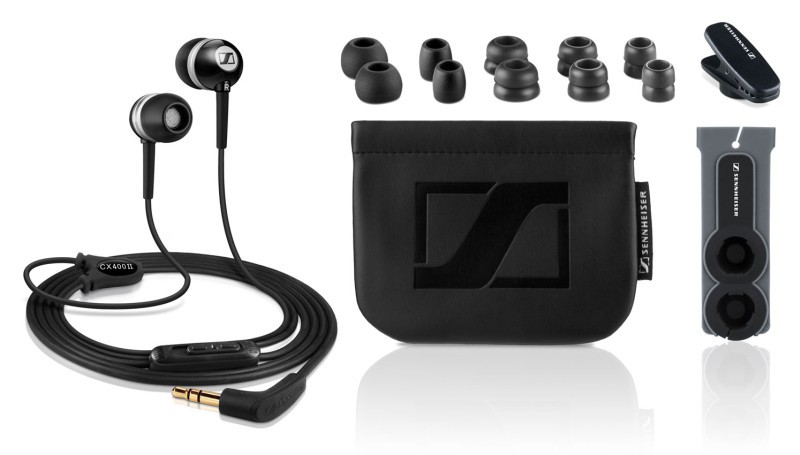
If you want to buy reinforcing headphones, but at the same time inexpensive, then your choice is single-driver models. I still have a very good Ultimate Ears UE600 model (with a dilapidated connector on a non-removable cable, by the way), but the cheap SoundMagic PL50 purchased earlier for testing sounded somehow quite dull, their only plus is miniature and lightweight. In general, reinforcing headphones are worth it to include them in the list of models under consideration and, on occasion, try before buying, but no more.
Custom headphones, the body of which is made according to the cast of your ear, solve the problem of nozzles. This is probably the next stage in the development of my headphone infrastructure, although I also have a lot of theoretical complaints about this approach.
Bright future
As I said, my approach to buying devices for listening to music suggests that these devices will last me a long time. In the case of "plugs", you can lay five years, in the case of home large headphones - at least twenty-five. When will I want to replace some headphones with new ones? Obviously when the old ones break. And before that, what could be the reason? Will current headphones cease to suit me in terms of sound quality? This is unlikely.
That is, the correct answer to this question is this. I will change my headphones when I have a budget for something new. Either I can experiment with custom in-ear-monitors (which is such an expensive pleasure), or there will be money for ready-made headphones of a completely new type. And, umm, so far I see only one type of headphone, which is seriously different from what I currently have, both in design and price:
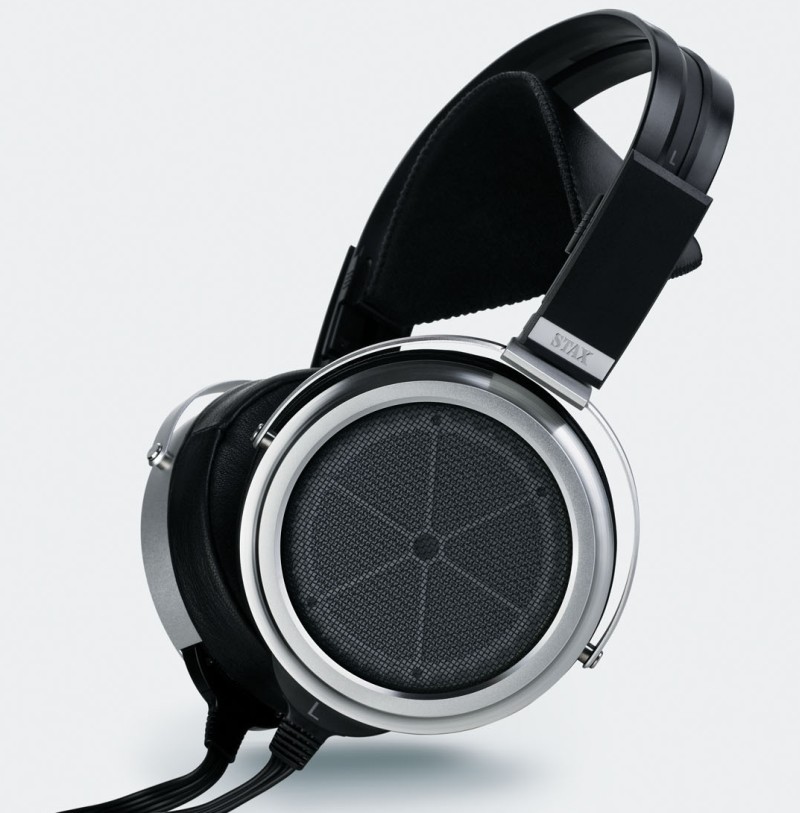
Japanese Stax electrostatic headphones are not of the very top model, and complete with the special one required for them an amplifier costs more than 70,000 rubles, and the price of the coolest in general exceeds 400 thousand rubles, and the amplifier is not included. Realistically assessing their career prospects, I guess that such a moment will never happen :)
Well, that means you have to rejoice at what is, and listen to more music, not devices.
